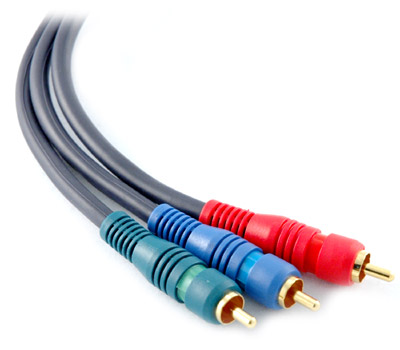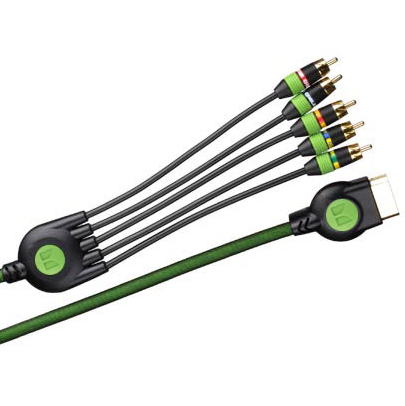Component Video Cables
Component video cables, like S-Video cables, are dedicated to one task; the task of transmitting video between home theater components. These video cables look similar to composite cables in that component video cables are also split into three separate lines with RCA connectors at the ends of each. However, this is where the similarities between the two cease. In actuality, the internal composition of component video cables is coaxial.
How Component Video Cables Work
 Component video cables take the concept
of separating signals a step further than S-Video cables.
Where S-Video cables separate the video signal into color and luminance
or brightness, component video cables divide the signal into red,
green, and blue. These are the primary colors of the
audio/video world. Every other color displayed on your
television or computer monitor is a mixture of these three.
Since each of these colors no longer has to share the same path with
the others, more information pertaining to each can be sent with fewer
errors and distortion.
Component video cables take the concept
of separating signals a step further than S-Video cables.
Where S-Video cables separate the video signal into color and luminance
or brightness, component video cables divide the signal into red,
green, and blue. These are the primary colors of the
audio/video world. Every other color displayed on your
television or computer monitor is a mixture of these three.
Since each of these colors no longer has to share the same path with
the others, more information pertaining to each can be sent with fewer
errors and distortion.The RCA connectors of the component video cable are denoted with the color that each transmits and the connection on your home theater components are similarly color coded. The entire home theater industry follows this color code standard.
Applications of Component Video Cables
You can find component video connections on various video electronics released in the past few years. While the configuration of the cables is often designed specifically by the manufacturer, the latest generation of video game consoles all have the ability to use component video. The difference in quality between component video cables and composite cables is remarkable on these video game consoles. You can also find component video
connections on televisions, DVD players, and home theater
receivers.
video game consoles. You can also find component video
connections on televisions, DVD players, and home theater
receivers. Component video cables allow DVD players to use their progressive scan capabilities with compatible televisions. When selecting the cables for this purpose, look for those with bandwidths that are greater than 12 MHz. With high-definition televisions (HDTV), choose component video cables with greater than 30 MHz bandwidth.
Note: Nintendo recently stopped including the component video cable port on the Gamecube system citing low consumer use.